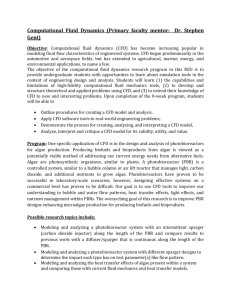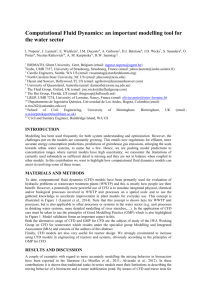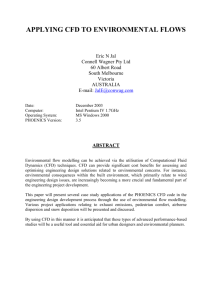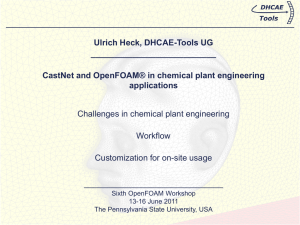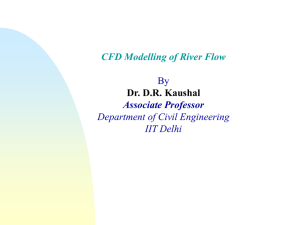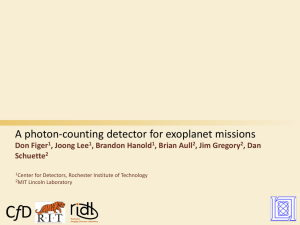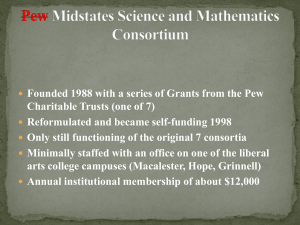CFD Education in Undergraduate Curriculum DG
advertisement
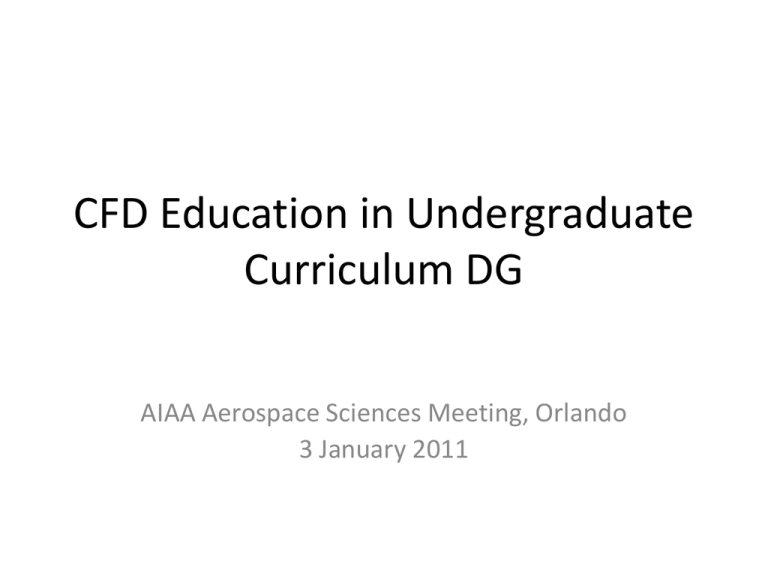
CFD Education in Undergraduate Curriculum DG AIAA Aerospace Sciences Meeting, Orlando 3 January 2011 Attendees • • • • Jeff Eldredge, UCLA Greg Blaisdell, Purdue Russ Cummings, USAFA Sidra Silton, US Army Research Lab Agenda • Recap of DG objectives • Previous action items from Chicago • Discussion of timeline of immediate and future activities for this DG • Discussion of survey • Discussion of necessary components of final objective: a “Best practices report” on CFD education in undergraduate curriculum • Previous experiences and lessons learned • Division of labor for moving forward Objectives of this DG 1. Should there be undergraduate CFD education, and if so, in what form? 2. Information gathering: Examine and discuss the current computation-related curricula of mechanical and aerospace engineering departments. Also, discuss current texts and their relative strengths/merits for undergrad CFD education. 3. Discussion: Itemize the basic curriculum elements that will best prepare undergraduate students for informed and thoughtful application (‘intelligent users and observers’) of CFD tools in their career (including graduate school). 4. Expert recommendation: Work together to formulate a recommendation report that can eventually be used by departments, particularly those undergoing curriculum reform processes. Action items from summer meeting Work on draft of survey questions: This will be done by everyone, through iteration, after I email the first draft soon. Complete by end of September. Compile a list of survey respondents: Should we hone this list name by name, or simply add all members of the Fluids and Applied Aero TCs and let the list filter itself naturally? All: Give me suggestions for how to proceed. Complete list by end of September. • Check in with other potential related efforts (e.g. AIAA Educational Activities standing committee, Fred Stern at Univ. Iowa, Nick G. mentioned effort by Allan Arrington on programming survey). Jeff E. will do this. (SEE JOINT INVITED SESSION BELOW) Proposed timeline of DG activities • Summer and Fall 2010: Survey construction, administration and processing, to be discussed at ASM Orlando in January 2011. • Summer 2011: Invited session at 2011 Fluid Dynamics meeting? (Blaisdell is CFD tech chair, Honolulu). Education session. Move to ASM 2012, in coordination with Applied Aero TC activity. • January 2012: Final report Survey • Distributed in early December using Vovici, with help from Patrick Liu at AIAA. • As of 3 January 2011, 42 responses (40 complete) out of ~120 invitations. • (See Excel spreadsheet for analysis) Survey Open questions: • Do we have enough responses and in a reasonable balance (between academic, industry, government)? • More specific from last question: Can we infer from the responses a general sense of the fluids community on whether the CFD belongs in the undergraduate curriculum and in what form? Invited session at 2012 ASM, Nashville • To be coordinated with Aaron Altman of Applied Aero TC, on aeronautics education. • Talks on CFD curriculum experiences and lessons learned from relevant academic members • Talks from industry representatives (i.e. employers)? • Written, oral or both? • Make sure Academic Affairs committee knows about it, get their feedback. Computing in undergrad education. Nick G: Allan Arrington conducting a programming survey. • Might fit in with Engineer 2020 initiative • Need to line up invited speakers this spring. Final Objective: ‘Best practices’ report Exit strategy of this DG (-->WG): A public document that recommends the necessary curriculum elements and reform strategies for preparing engineering students for a variety careers in which CFD is an actively-used tool. NOTES: • • • Provide clear motivation for fluid dynamics curriculum reform This document should also provide ideas/examples about how such elements might be incorporated into an existing aerospace engineering (or mechanical engineering) curriculum, with as little disruption as possible. Sample syllabi might be included, for different purposes: – One syllabus for full semester (and 10-week term?) of CFD – One which incorporates CFD content into an intermediate fluid dynamics course • • • This should also delineate the necessary prerequisite material for courses that incorporate this content Also, a bibliography of textbooks (and reviews?) could be included. In CFD SC meeting in Chicago, Brian Smith raised important question about dissemination. Need to consider this. Perhaps as a AIAA Best Practices report? Who should be on distribution list? Final report work (target: 2012 ASM) • Establish scope of report – Aero department only, or also mechanical? (latter might require consideration of heat transfer computing) – Target only needs of industry-bound students, or also post-graduate research students? • A vague outline: – Motivation • Use results of surveys here – Tie-in to programming survey (and other surveys) – Previous experiences and lessons learned • Examples of syllabuses and curriculum context – – – – Examples of genuine CFD courses Examples of CFD modules in fluids courses Examples of CFD in engineering design courses Examples of CFD electives (versus required courses) • Examples of curriculum reform efforts – Recommended strategies Learning from previous efforts • Two aspects need to be covered: 1. 2. An appropriate syllabus for an undergrad CFD course, including the balance between fundamentals and application AND, a roadmap for how to re-arrange a traditional non-computing curriculum to incorporate the CFD content • A useful example of both is provided by the efforts at USAFA by Cummings et al. (AIAA 2005-1072). – Any final report from this DG should include the “lessons learned” from such an effort. – To this end, a survey of the instructors and recent graduates (with up to 5 years hindsight) would be useful. • Also, Fred Stern at Univ. Iowa (“CFD labs”, and inhouse software… commercially available?) Synergistic Activities • ETFD SC interested in DG on educational materials. Led by Mike Plesniak and Greg Elliott.
